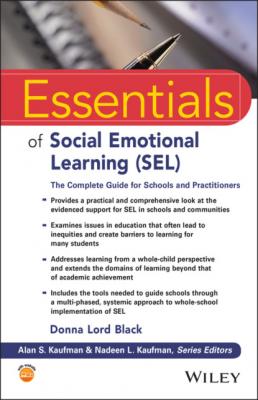ТОП просматриваемых книг сайта:
Essentials of Social Emotional Learning (SEL). Donna Lord Black
Читать онлайн.Название Essentials of Social Emotional Learning (SEL)
Год выпуска 0
isbn 9781119709220
Автор произведения Donna Lord Black
Издательство John Wiley & Sons Limited
3 Committee for Children. (2020). What is social‐emotional learning? https://www.cfchildren.org/what‐is‐social‐emotional‐learning/
4 Common Core State Standards Initiative. (2020). Preparing America’s students for success. http://www.corestandards.org
5 Davis, J. (2018). Aligned in Anchorage. The Learning Professional, 39(4), 26–29, 35.
6 Education First. (2016). Social and emotional learning: Why students need it. What districts are doing about it. https://education‐first.com/wp‐content/uploads/2016/10/Education‐First_Social‐and‐Emotional‐Learning_‐October‐2016.pdf
7 Ecological Approaches to Social Emotional Learning Laboratory [EASEL Lab]. (2020). Harvard Graduate School of Education. Retrieved April 21, 2020 from http://eploresel.gse.harvard.edu/faq/#included‐frameworks
8 Finn, C. E., & Hess, F. M. (2019). What social and emotional learning needs to succeed and survive. Washington, DC: American Enterprise Institute. https://www.educationnext.org/what‐social‐emotional‐learning‐needs‐succeed‐survive/
9 Gorman, N. (2016). Critics of social emotional learning standards call it a fad, ‘non‐academic common core’. Education World. https://www.educationworld.com/a_news/critics‐social‐emotional‐learning‐standards‐call‐it‐fad‐non‐academic‐common‐core‐498184814
10 Jones, S., Bailey, R., Brush, K., & Nelson, B. (2019). Introduction to the Taxonomy Project: Tools for selecting and aligning SEL frameworks. Measuring SEL. https://measuringsel.casel.org/frameworks/
11 National Commission on Social, Emotional, and Academic Development (NCSEAD). (2019). From a nation at risk to a nation at hope. Washington, DC: ASPEN Institute.
12 Pullman, J. (2016). Tennessee to create ‘safe spaces’ in K‐12 schools. The Federalist. https://thefederalist.com/2016/08/08/tennessee‐to‐create‐safe‐spaces‐in‐k‐12‐schools/
13 Schonert‐Reichl, K. A., Kitil, M. J., & Hanson‐Peterson, J. (2017). To reach the students, teach the teachers: A national scan of teacher preparation and social and emotional learning. Report prepared for the Collaborative for Academic, Social, and Emotional Learning (CASEL). Vancouver, BC: University of British Columbia.
14 Search Institute. (2020). The Developmental Assets Framework. https://www.search‐institute.org/our‐research/development‐assets/developmental‐assets‐framework/
15 Shriver, T. P., & Weissberg, R. P. (2020). A response to constructive criticism of social and emotional learning. Phi Delta Kappan, 101(7), 52–57.
16 Texas Education Agency and Region 4 Education Service Center. (2010). Texas Collaborative for Emotional Development in Schools (TxCEDS) Stakeholder Group report: Social‐emotional wellness in Texas schools: A guide for schools, agencies, organizations, parents, and communities (Project Coord. D. Black). Houston, TX: Region 4 Education Service Center.
17 World Economic Forum. (2016). New vision for education: Fostering social and emotional learning through technology. http://www3.weforum.org/docs/WEF_New_Vision_for_Education.pdf
18 Zhao, U. Y. (2020). Another education war? The coming debates over social and emotional learning. Phi Delta Kappan, 101(8). https://kappanonline.org/another‐education‐war‐social‐emotional‐learning‐debates‐zhao/
Two HISTORICAL INFLUENCES ON THE EMERGENCE OF SEL
INTRODUCTION
The knowledge we gain from history is not only informative, but transformative as well. It gives us insight into current‐day problems, provides context to our efforts, guides us forward, and encourages us to think critically about future efforts as we strive to advance and promote SEL in schools. This chapter will explore recent events to highlight how awareness of the need for SEL has been propelled to the forefront of education. This will be followed by an investigation into past events, primarily within the United States, from which SEL has emerged, to illustrate how it has evolved over several decades. Through this systematic review, we can reflect on the impact of SEL and subsequently analyze how it might guide our efforts forward to help influence positive outcomes for our students. The goal of the review is not to memorize a bombardment of facts or to confirm and admire existing problems, but to use the information constructively to help us conceptualize a best approach for moving forward and advancing our efforts.
DON’T FORGET
Understanding SEL from a historical perspective helps us move from admiring existing problems to promoting viable solutions.
RECENT EVENTS
COVID‐19 Pandemic 2020
The pandemic of 2020 drove concerns about emotional functioning into the spotlight for people of all ages, but especially for children and youth on whom the impact of social distancing and social isolation had the most debilitating effects. As the virus worsened and spread, the prolonged isolation from being quarantined led to growing concerns for how it was impacting young people’s social and emotional well‐being. These concerns became far more worrisome as the quarantine extended into months. Interestingly, while there also were concerns for the physical health of children and youth, these were perhaps tempered by early reports in which it was originally believed that younger people were less susceptible to contracting the virus. Consequently, worries over their physical safety were less concerning, that is, until the quarantine progressed. As the virus grew and spread, reports of younger people contracting the virus began to emerge and the medical community began to further explore these cases. What they soon discovered was that the virus manifested differently in young people than it did in the older population. Thus, health concerns for children and youth began to rise, and the virus soon became linked to a new inflammatory syndrome with serious implications for young people’s health. Additional information about this syndrome can be explored in detail in Rapid Reference 2.1.
Inflammatory Syndrome in Young People Linked to COVID‐19
Although adults (especially older adults) were thought to be at greater risk for contracting the virus, it quickly became evident that children and youth were not immune. Clusters of children began to emerge with a COVID‐19‐linked illness called pediatric multisystem inflammatory syndrome (PMIS). This syndrome resembled a rare inflammatory illness very similar to Kawasaki disease, but manifested

